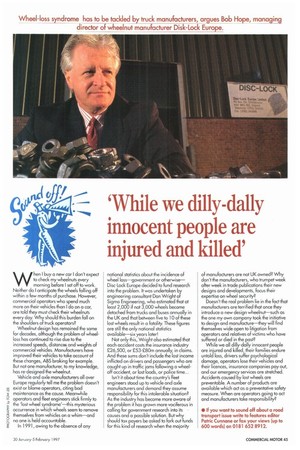'While we dilly-dally innocent people are injured and killed'
Page 47

If you've noticed an error in this article please click here to report it so we can fix it.
When I buy a new car I don't expect to check my wheelnuts every morning before I set off to work. Neither do I anticipate the wheels falling off within a few months of purchase. However, commercial operators who spend much more on their vehicles than I do on a car, are told they must check their wheelnuts every day. Why should this burden fall on the shoulders of truck operators?
Wheelnut design has remained the same for decades, although the problem of wheelloss has continued to rise due to the increased speeds, distances and weights of commercial vehicles. Manufacturers have improved their vehicles to take account of these changes, ABS braking for example. But not one manufacturer, to my knowledge, has re-designed the wheelnut. Vehicle and axle manufacturers all over Europe regularly tell me the problem doesn't exist or blame operators, citing bad maintenance as the cause. Meanwhile operators and fleet engineers stick firmly to the 'lost wheel syndrome'—this mysterious occurrence in which wheels seem to remove themselves from vehicles on a whim—and no one is held accountable.
In 1991, owing to the absence of any national statistics about the incidence of wheel loss—government or otherwiseDisc-Lock Europe decided to fund research into the problem. It was undertaken by engineering consultant Don Wright of Sigma Engineering, who estimated that at least 2,000 if not 3,000 wheels become detached From trucks and buses annually in the UK and that between Five to 10 of these lost wheels result in a fatality. These figures are still the only national statistics available—six years later! Not only this, Wright also estimated that each accident costs the insurance industry 226,500, or 253480m annually, in claims. And these sums don't include the lost income inflicted on drivers and passengers who are caught up in traffic jams following a wheeloff accident, or lost loads, or police time... Isn't it about time the country's fleet engineers stood up to vehicle and axle manufacturers and demand they assume responsibility for this intolerable situation? As the industry has become more aware of the problem it has grown more vociferous in calling For government research into its • causes ancfa possible solution. But why should tax payers be asked to fork out funds for this kind of research when the majority of manufacturers are not UK owned? Why don't the manufacturers, who trumpet week after week in trade publications their new designs and developments, focus their expertise on wheel security? Doesn't the real problem lie in the Fact that manufacturers are terrified that once they introduce a new design wheelnut—such as the one my own company took the initiative to design and manufacture—they will find themselves wide open to litigation from operators and relatives of victims who have suffered or died in the past? While we all dilly-dally innocent people are injured and killed, their families endure untold loss, drivers suffer psychological damage, operators lose their vehicles and their licences, insurance companies pay out, and our emergency services are stretched. Accidents caused by lost wheels are preventable. A number of products are available which act as a preventative safety measure. When are operators going to act and manufacturers take responsibility?








































































































